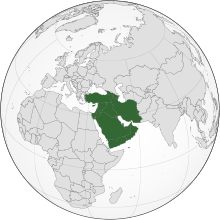
Back Asia Barat ACE Wes-Asië Afrikaans غرب آسيا Arabic ܐܣܝܐ ܡܥܪܒܝܬܐ ARC Asia Occidental AST БакътӀерхьул Азия AV Taltefa Asia AVK Ön Asiya Azerbaijani باتی آسیا AZB Алғы Азия Bashkir
 | |
| Area | 5,994,935 km2 (2,314,657 sq mi)a |
|---|---|
| Population | 313,450,000 (2018) (9th)[1][2] |
| Population density | 50.1/km2 (130/sq mi) |
| GDP (PPP) | $9.063 trillion (2019)[3] |
| GDP (nominal) | $3.383 trillion (2019)[3] |
| GDP per capita | $10,793 (2019; nominal)[3] $28,918 (2019; PPP)[3] |
| HDI | |
| Ethnic groups | Arabs, Persians, Turks, Kurds, Azerbaijanis, Armenians, Jews, Assyrians, Baloch, etc. |
| Religions | Islam, Christianity, Judaism, Baháʼí, Druzism, Yarsanism, Yazidism, Zoroastrianism, Mandaeism, Hinduism, Buddhism, etc. |
| Demonym | West Asian Western Asian |
| Countries |
3 unrecognized |
| Dependencies | |
| Languages | Official languages Other languages |
| Time zones | 5 time zones |
| Internet TLD | .ae, .am, .az, .bh, .cy, .eg, .ge, .il, .iq, .ir, .jo, .kw, .lb, .om, .ps, .qa, .sa, .sy, .tr, .ye |
| Calling code | Zone 9 except Armenia, Cyprus (Zone 3) & Sinai (Zone 2) |
| Largest cities | |
| UN M49 code | 145 – West Asia142 – Asia001 – World |
a Area and population figures include the Sinai b Among the top 100 urban areas of the world by population | |
West Asia, also called Western Asia or Southwest Asia, is the westernmost region of Asia. As defined by most academics, UN bodies and other institutions, the subregion consists of Anatolia, the Arabian Peninsula, Iran, Mesopotamia, the Armenian highlands, the Levant, the island of Cyprus, the Sinai Peninsula and the South Caucasus.[4][5][6] The region is separated from Africa by the Isthmus of Suez in Egypt, and separated from Europe by the waterways of the Turkish Straits and the watershed of the Greater Caucasus. Central Asia lies to its northeast, while South Asia lies to its east. Twelve seas surround the region (clockwise): the Aegean Sea, the Sea of Marmara, the Black Sea, the Caspian Sea, the Persian Gulf, the Gulf of Oman, the Arabian Sea, the Gulf of Aden, the Red Sea, the Gulf of Aqaba, the Gulf of Suez, and the Mediterranean Sea. West Asia contains the majority of the similarly defined Middle East. The Middle East is a political term that has changed many times depending on political and historical context while West Asia is a geographical term with more consistency. It excludes most of Egypt and the northwestern part of Turkey, and includes the southern part of the Caucasus.
West Asia covers an area of 5,994,935 km2 (2,314,657 sq mi), with a population of about 313 million.[1][2] Of the 20 UN member countries fully or partly within the region, 13 are part of the Arab world. The most populous countries in West Asia are Iran, Turkey, Iraq, Saudi Arabia and Yemen.
In the World Geographical Scheme for Recording Plant Distributions (WGSRPD), West Asia excludes the Arabian Peninsula and includes Afghanistan.[7] The Food and Agriculture Organization (FAO) excludes Egypt and includes Afghanistan.[8] The United Nations Environment Programme excludes Cyprus, Israel, Turkey, and Iran from West Asia.[9]
- ^ a b "World Population prospects – Population division". United Nations. Archived from the original on 5 February 2019. Retrieved 16 July 2019.
- ^ a b "Overall total population" (xlsx). United Nations. Retrieved 16 July 2019.
- ^ a b c d "World Economic Outlook Database". imf.org. IMF. Outlook Database, October 2020
- ^ "Land Use Dynamics and Institutional Changes in West Asia" (PDF).
- ^ "Western Asia". Library of Congress, Washington, D.C. 20540 USA. Retrieved 2024-04-14.
- ^ "World Geographical Scheme for Recording Plant Distributions" (PDF). Archived from the original (PDF) on 2016-01-25.
- ^ Brummitt, R. K. (2001). World Geographical Scheme for Recording Plant Distributions (PDF) (2nd ed.). International Working Group on Taxonomic Databases For Plant Sciences (TDWG). Archived from the original (PDF) on 2016-01-25. Retrieved 2021-07-27.
- ^ "Chapter 21. West Asia". www.fao.org. Retrieved 2023-07-17.
- ^ Environment, U. N. (2023-04-12). "West Asia". Ozonaction. Retrieved 2023-12-12.